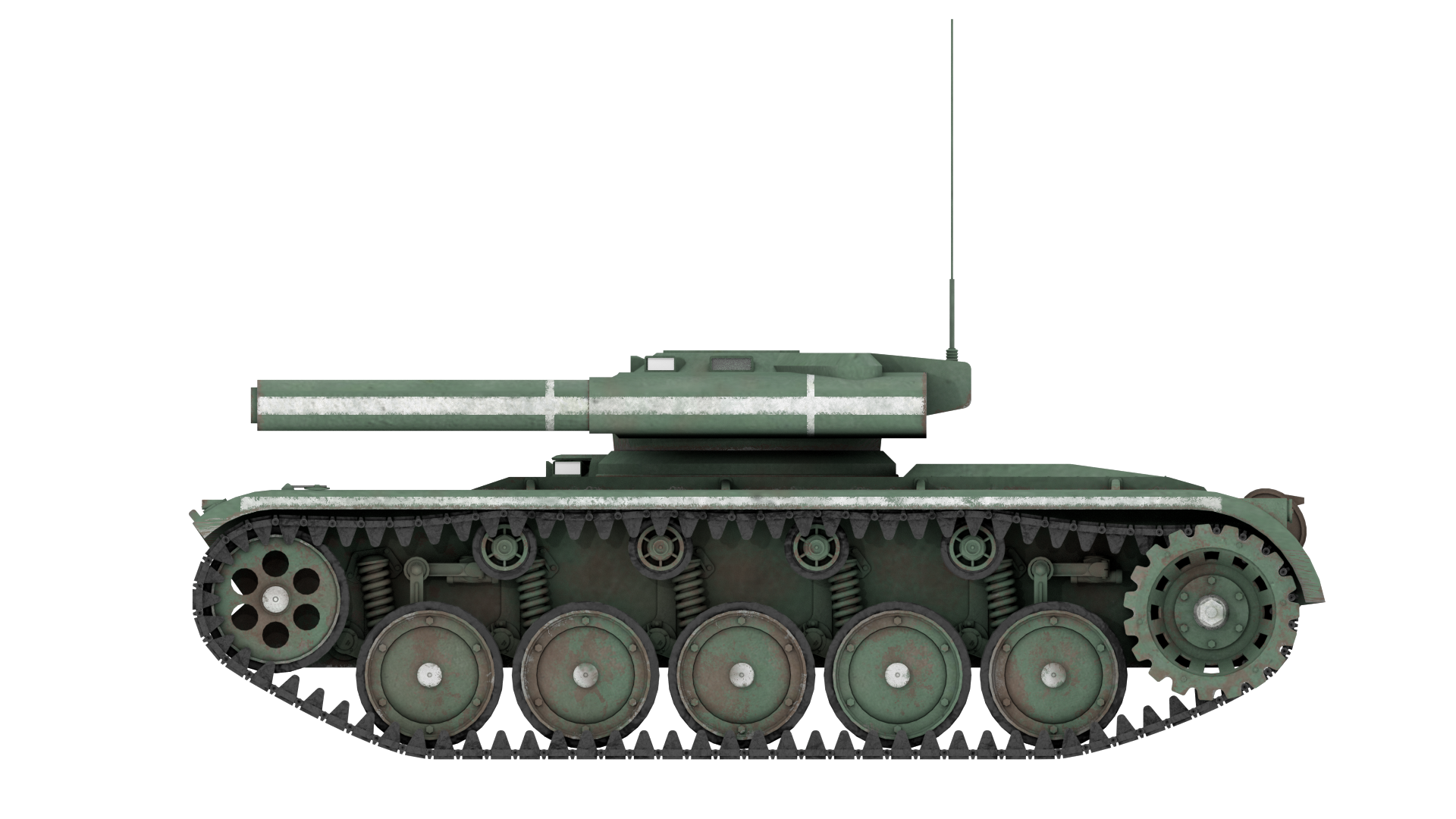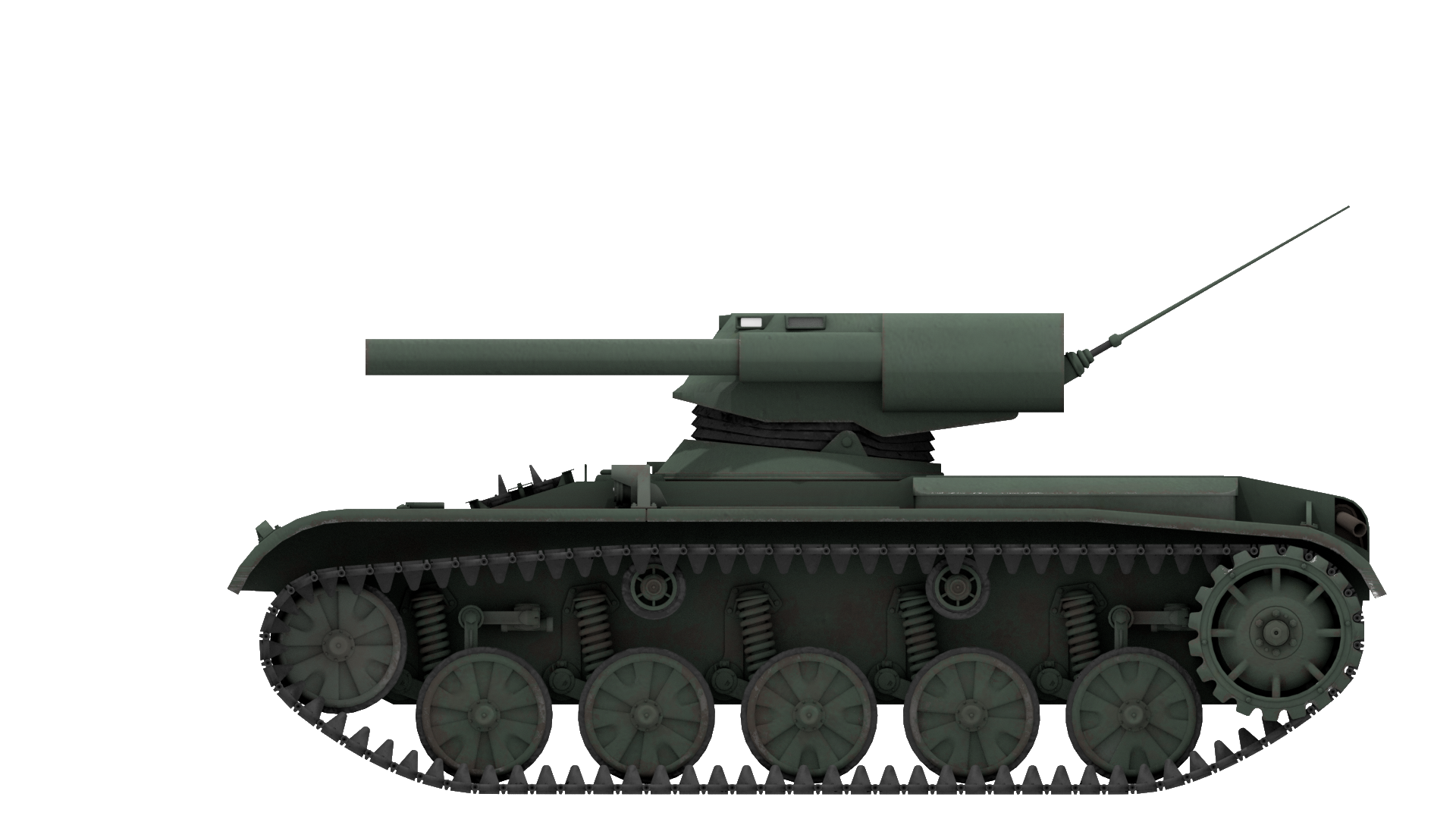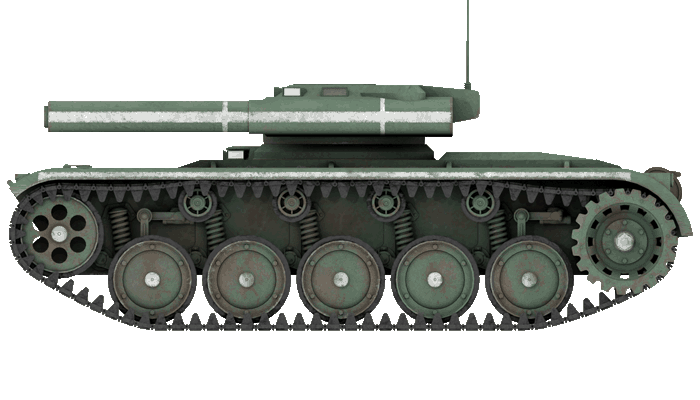 France (1953-1957)
France (1953-1957)
Airborne Light Tank Destroyer – 1 Prototype Built
In the years that followed France’s liberation at the end of the Second World War, the French arms industry, once a world leader but vastly weakened by years of war and occupation, started to re-develop. A number of original vehicle concepts were experimented. One of the odder, but also one which was studied the most extensively, was the concept of very light tank destroyers. These vehicles were rather similar in size and weight to the ‘tankettes’ of the interwar years but were intended to perform a different role. New anti-tank technology, particularly recoilless anti-tank rifles, were used to turn vehicles of this size into efficient tank destroyers. The first known design of such a vehicle appears to date from 1950 and was designed by a military engineer named Pommelet. Apparently it was a very small vehicle armed with an American M20 Super Bazooka and had a crew of just one. While little to no information and no photographs of this prototype appear to have survived to this day, a number of prototypes based on similar principles would appear in the following years.
In 1951, a tank destroyer concept was submitted by an engineer by the name of Henry. This is the oldest of such vehicles of which visual evidence is available. The ‘Henry tank destroyer’ was a tiny, tracked vehicle, armed with a recoilless gun of unknown caliber firing through the vehicle’s axis. The vehicle was planned to have a crew of two men and included inflatable balloons and hydraulic skis. These were supposed to make it amphibious as well as to allow it to easily cross swamps or snowy terrain. This particular vehicle did not go past the design board.

Endorsement of Light Tank Destroyer Projects
Marshall Juin was one of the most prestigious and well-known French officers after the Second World War, having notably commanded the Free French Corps in Italy. In July 1952, he officially requested the development of a very light tank destroyer armed with recoilless guns. In March 1953, a military commission confirmed the request. The vehicle wanted was a light ‘intervals machine’ (a vehicle meant to cover the spaces left between tank units) armed with either 75 mm, 105 mm or 150 mm recoilless guns, or a Brandt 120 mm rocket launcher. Following this official call for designs, the scope of designers and companies working on a very light tank destroyer expanded, as large companies such as AMX-Hotchkiss and Lorraine got involved. One project, though, was developed by the Etablissements Brunon-Valette – a smaller company that had been producing various products, from bridges, to bottles, to chassis, but had little to no previous experience in the field of military vehicles. The company’s efforts at making a light tank destroyer were led by an engineer of which we only have the last name, Even; this name would be given to his design as well.
The First EVEN Design
The design process of the first version of Even’s light tank destroyer was rather swift, with a mockup being ready for presentation by January 1954, alongside the Lorraine and AMX-Hotchkiss designs. Even’s vehicle had a small and particularly short hull, with a height of 1.4 m with the turret, a width of 2.15 m and a length of 5.3 m. It was very lightly armored, with a maximum of 10 mm on the frontal plate, and 8 mm on the rest of the hull. The vehicle was intended to resist 7.62 mm rounds, anti-personnel landmines and artillery shell splinters. Unsurprisingly for such a small and lightly armored vehicle, it had a very modest weight of just 5 tons and was powered by a SOFAM 168 hp engine placed at the rear of the vehicle. The engine compartment was separated from the rest of the hull by a fireproof partition. The vehicle was able to reach a maximum speed of 75 km/h on-road, and 40 off-road. Two headlights featured on the front armor plate. The driver was placed at the front, gaining access through a large hatch. Unlike the vast majority of armored vehicles, the driver did not sit, but lay down on his back in an awkward position. The internal space was too low for him to even sit. A rather peculiar turret was fitted to the vehicle. as it was not centered, but off to the left, whilst the driver’s compartment and hatch were on the right side of the vehicle. The space given to the gunner was rather small, and he sat on a seat placed on the bottom of the vehicle’s hull. The vehicle was so short that the eyes of a man of average height would be well-placed to align with the gun’s sights. The gunner could enter and exit the vehicle through the turret’s top hatch.
The vehicle was armed with four Brandt 120 mm rocket launchers, two sitting on each side of the turret, firing SNEB rocket-powered projectiles. A 7.5 mm AA52 machine-gun featured on both sides of the turret. It appears that the turret’s armor was somewhat thicker than the hull’s, with 15 mm of steel. With the turret on, the Even vehicle had a weight of about 7.4 tons, reducing its maximum speed to 68 km/h. The vehicle was protected from combat gas and, according to the French Army’s reports on the vehicle, even from nuclear fallout, thanks to a filtered pressurized air system. Communications were assured by an ANVRC 7 radio placed at the rear of the turret. Intercom was used inside the vehicle, though direct voice commands could also be formulated in case it did not work.

One of the hardest challenges faced by Even was planning the vehicle’s reloading process. The guns were attached to the turret, and their breeches could not be reloaded from inside of the vehicle. Two different ways of reloading the vehicle existed, both performed by the driver:
The first allowed him to reload without leaving his seat, the turret would rotate so the breeches would be near the driver’s position (meaning the gun would face the rear). The driver then had to open his hatch and could shove the 120 mm rocket-shells into the breeches while remaining in his lying down position. This technique allowed him to remain inside the vehicle but was quite slow and hard to perform.
A simpler alternative, but also one that made him more vulnerable, was exiting the vehicle and reloading the breeches from the outside.
A third alternative existed on paper, but appears not to have been carried on the mockup and prototype: making the rear of the barrels rotatable, so the gunner could reload them from his position by opening the turret’s hatch.
A drum-loaded variant of the vehicle was also considered. It reduced the number of 120 mm Brandt rocket launchers to just one per side of the turret. Each one was fed by a 5-round magazine that could load a shell every 3 to 4 seconds before running out. This version did not leave the drawing board, as it raised Even’s vehicle height by about 20 centimeters and reloading the drums under fire was judged to be very hazardous, even more so than for the four-gun version of the vehicle.


The 1956 Prototype
The first prototype of Even’s vehicle was completed in July 1955, with testing performed in July 1956. In the meantime, the official requirements had changed quite a bit. In 1955, the French Army requested that the vehicle should use classic anti-tank guns, as the recoilless option, while attractive considering it could allow an impressive amount of firepower on a very small platform, lacked the accuracy and range for proper anti-tank warfare. The project also officially received a name in December 1955, as the Engin Léger de Combat – Light Combat Machine, or ELC for short. Despite the change in requirements, the first prototype of Even’s vehicle, now named the ELC EVEN, still featured the recoilless 120 mm rocket launchers.
The trials performed in July 1956 concerned both the guns and EVEN’s platform itself. These trials showed that, at a range of 451 meters, the Brandt rocket launched SNEB rockets had a horizontal dispersion of up to 4.36 m, and a vertical dispersion of up to 3.05 m, making the vehicle’s accuracy unreliable past almost point-blank range. The shells had a penetration of about 300 mm, which was the same at all distances thanks to the use of shaped charges.
The mobility trials were performed on two different terrains: the first one was a relatively flat, grassy and dry terrain, which the ELC EVEN crossed easily at a speed averaging 40 km/h. The second type of terrain was one that included a number of potholes, ditches and trenches. In it, the vehicle ended up getting stuck at the bottom of a ditch, after the driving shaft of the right sprocket was damaged.
The vehicle was apparently repaired rather quickly, as documents from November 1957 noted that the vehicle had crossed more than 7,000 km without any major technical issues. The documented results of the 1956 trials can be found HERE.
Conclusion – Abandoning the Recoilless Option
However, with prototypes of the next generation of ELCs in the work, this first recoilless gun-armed prototype would soon be abandoned. By November 1957, the prototype of the new version of the ELC would start undergoing trials. While the recoilless version of the ELC EVEN was not as successful as its successor, which would go pretty close to being adopted by the French Army, it nonetheless paved the way for the vehicle’s evolution. The fate and whereabouts of the 1956 prototype remain unknown to this day.
While they would never be adopted in a tank, recoilless guns would still remain in service in the French Army for many years to come. The most notable example would be the Hotchkiss M201 – a mere copy of the WW2 classic Willys MB Jeep. This French-produced model would, from 1963 onward, be fitted with 106 mm M40 recoilless guns in large numbers. These Jeeps were commonly used by the French Army, particularly during its intervention in various Sub-Saharan and Middle Eastern countries, in which its small weight and firepower were greatly appreciated, both against infantry and armor. They would remain in active service until they were replaced with vehicles armed with MILAN missiles in the early 90s.


The ELC EVEN with the four Brandt 120mm Recoilless rifles during the 1956 trials.

The ELC EVEN with the projected revolver loading system.
These illustrations were produced by Brian Gaydos, funded by our Patreon Campaign.
Specifications |
|
| Dimensions (L-W-H) | 5.30 x 2.15 x 1.60 meters (17.3 x 7 x 5.2 ft) |
| Weight, battle ready | 6.7 tonnes (7.3 tons) |
| Crew | 2 (commander/gunner and driver/loader)s |
| Engine | SOFAM 168 hp |
| Suspension | Leaf springs |
| Speed (road/off road) | 70 km/h / ~40 km/h (43 – 24 mph) |
| Range (road) | ~350 km (217 miles) |
| Armament | Four 120 mm Brandt recoilless guns/rocket launchers Secondary: Two AA52 7.5 mm machine-guns |
| Armor | 8-15 mm (0.3 – 0.59 in) |
| Total built | 1 prototype, 10 (5 90 mm armed and 5 30 mm-armed) pre-production vehicles |
Sources
French military archives in Châtellerault (see imgur albums)
www.chars-francais.net


5 replies on “ELC EVEN with 120 mm Recoilless Rifles”
Wow, this is amazing
really interesting, and very reminiscent of the Ontos
I consider it to be superior to Ontos vehicle. While it came little later, it had NBC protection together with higher caliber recoilless guns, would have more of umphf when hitting target. 105 mm recoilless rifles found on M50 Ontos were overall more efficient in penetrating armor and larger quantity of launchers enables it to provide more firepower as reloading tubes during combat was unrealistic, crew would need to find cover from direct fire first.
Vehicle itself is quite efficient in its space usage. However, I’m not certain how it can house two machine guns in an efficient fashion. It doesn’t seem practical to me. ELC EVEN has superior commander’s hatch compared to M50 Ontos. Its greatest advantage was its dimensions. Americans never got a memo about vehicle sizes and thus their tankette tank destroyer is as big as a tank! This tankette however is small enough to be a hassle to hit and it would receive various benefits for a shrewd commander like being able to hide in terrain a lot better.
The biggest downside I can see with this vehicle is that it might be impractical for crew to operate vehicle. Crew comfort is important and it might be necessary to enlarge design in order to place crew into more comfortable positions and with slightly bigger dimensions maybe designers could consider placing properly machine gun into this vehicle. This is important because historically from M50 Ontos experience, such vehicles were very important for fire support on small scale. Their recoilless rifles would punch through fortifications and machine gun might prove invaluable in such small scale actions if properly designed into armament of a vehicle.
It is shame that France did not produced such vehicles. They are a lot more potent than jeeps with recoilless guns and with more design work put into it, newer and better version could be deployed in 60’s while this vehicle would had served as fine intermedium solution.
The article alternates between calling the armament rocket launchers and recoilless rifles – the two are not interchangeable terms as their operating principles are completely different!
WobbyJohn,
The 120mm Brant recoiless uses a rocket assisted projectile while having the architecture of a classif rifled recoilless rifle